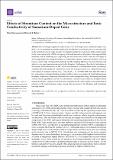Files in this item
Effects of strontium content on the microstructure and ionic conductivity of samarium-doped ceria
Item metadata
| dc.contributor.author | Sherwood, Toby | |
| dc.contributor.author | Baker, Richard | |
| dc.date.accessioned | 2021-08-10T09:30:16Z | |
| dc.date.available | 2021-08-10T09:30:16Z | |
| dc.date.issued | 2021-08-10 | |
| dc.identifier | 275333967 | |
| dc.identifier | 3c2de1ed-d43f-46eb-bc1f-5e2ec99d8eb4 | |
| dc.identifier | 85135030676 | |
| dc.identifier.citation | Sherwood , T & Baker , R 2021 , ' Effects of strontium content on the microstructure and ionic conductivity of samarium-doped ceria ' , Solids , vol. 2 , no. 3 , pp. 293-313 . https://doi.org/10.3390/solids2030019 | en |
| dc.identifier.issn | 2673-6497 | |
| dc.identifier.other | ORCID: /0000-0002-3304-3280/work/98487756 | |
| dc.identifier.uri | https://hdl.handle.net/10023/23750 | |
| dc.description | We thank the School of Chemistry, University of St Andrews for a PhD studentship for TS. | en |
| dc.description.abstract | Due to its high oxygen ion conductivity at elevated temperatures, samarium-doped ceria (SDC) is a very promising material for application in solid state electrochemical devices and especially in the electrolytes of solid oxide fuel cells. Several prior studies have reported a further improvement in the ionic conductivity of SDC on doping with small amounts of strontium. It is suggested that strontium acts as a sintering aid—improving the microstructure of SDC—and as a scavenger of silicon impurities, decreasing its tendency to form resistive phases at grain boundaries. However, because of the range of preparation methods and the resulting differences in microstructure and silicon levels, some inconsistencies exist in the literature. Furthermore, the effect of strontium on the intrinsic (bulk) conductivity of SDC is not often discussed. To address these issues, a systematic, combined microstructural and conductivity study has been performed on a compositional series with a range of strontium contents, Ce0.8−xSm0.2SrxO2−δ (x = 0, 0.002, 0.005, 0.01, 0.02, 0.03, 0.04). A low temperature synthesis affording products with low silicon was employed. Total bulk and grain boundary conductivity data were obtained over a wide temperature range. Increasing strontium content caused a general decrease in total and intrinsic conductivity, but there was an improvement in grain boundary conductivity at the lowest strontium levels. These results were interpreted by reference to the microstructures using, among other parameters, the blocking, and normalised blocking, factors. | |
| dc.format.extent | 3919966 | |
| dc.language.iso | eng | |
| dc.relation.ispartof | Solids | en |
| dc.subject | Solid Oxide Fuel Cell | en |
| dc.subject | Oxygen ion conductor | en |
| dc.subject | Electrolyte | en |
| dc.subject | Impedamce spectroscopy | en |
| dc.subject | Ceria | en |
| dc.subject | Strontium | en |
| dc.subject | QD Chemistry | en |
| dc.subject | NDAS | en |
| dc.subject.lcc | QD | en |
| dc.title | Effects of strontium content on the microstructure and ionic conductivity of samarium-doped ceria | en |
| dc.type | Journal article | en |
| dc.contributor.institution | University of St Andrews. Centre for Energy Ethics | en |
| dc.contributor.institution | University of St Andrews. St Andrews Sustainability Institute | en |
| dc.contributor.institution | University of St Andrews. EaSTCHEM | en |
| dc.contributor.institution | University of St Andrews. School of Chemistry | en |
| dc.identifier.doi | https://doi.org/10.3390/solids2030019 | |
| dc.description.status | Peer reviewed | en |
| dc.identifier.url | https://www.mdpi.com/2673-6497/2/3/19 | en |
This item appears in the following Collection(s)
Items in the St Andrews Research Repository are protected by copyright, with all rights reserved, unless otherwise indicated.

